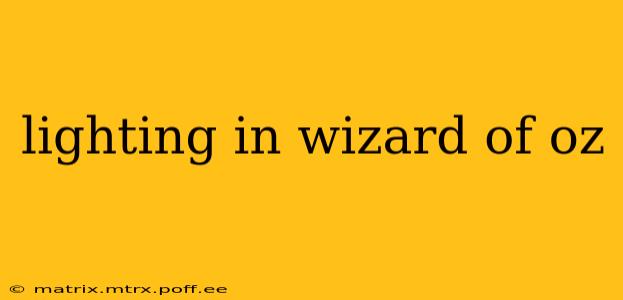The Wizard of Oz, a timeless classic, captivates audiences not only with its enchanting story but also with its groundbreaking use of color and lighting. From the sepia-toned Kansas to the vibrant technicolor Land of Oz, the film's lighting plays a crucial role in establishing mood, setting the scene, and enhancing the magical realism. This exploration delves into the technical achievements and artistic choices behind the dazzling visuals that make The Wizard of Oz so unforgettable.
What kind of lighting techniques were used in The Wizard of Oz?
The lighting in The Wizard of Oz represents a significant leap forward in cinematic technology. The transition from sepia Kansas to the vibrant Oz was a revolutionary feat, achieved through the innovative use of three-strip Technicolor. This process, while challenging, allowed for a wider range of colors and a level of saturation previously unseen in film. Beyond Technicolor, the film skillfully utilizes various lighting techniques to achieve specific effects. These include:
-
High-key lighting: Used extensively in the Land of Oz to create a bright, cheerful, and almost dreamlike atmosphere. This technique minimizes shadows and emphasizes the vibrant colors, contributing to the fantastical setting.
-
Low-key lighting: Employed more sparingly, often to create a sense of mystery or danger. Scenes in the forest, or those involving the Wicked Witch, utilize low-key lighting to cast shadows and heighten suspense.
-
Backlighting: Used to create silhouettes and highlight the characters against the backdrop, adding depth and dimension to the scenes. This technique is particularly effective in showcasing the grandeur of Oz's landscapes.
-
Selective lighting: Specific areas or characters are highlighted while others are left in shadow, drawing the viewer's attention to particular elements within the scene. This helps guide the narrative and emphasize crucial moments.
How did the lighting help create the different moods in the film?
The lighting in The Wizard of Oz masterfully reflects the shifting emotional landscape of the film. The muted, almost monochrome tones of Kansas establish a sense of melancholy and longing for something more. This stark contrast to the explosion of color in Oz immediately sets a different tone, illustrating Dorothy’s escape into a fantastical world.
The vibrant lighting in Oz emphasizes the playful and whimsical aspects of the story. The bright, saturated colors enhance the feeling of wonder and excitement, mirroring Dorothy’s journey of discovery. Conversely, the darker and more shadowy scenes, particularly those involving the Wicked Witch, utilize lighting to heighten tension and create a sense of foreboding. The lighting effectively communicates the underlying themes of good versus evil, hope versus despair.
What role did color play in the lighting design of The Wizard of Oz?
Color is integral to the overall impact of the film's lighting. The stark contrast between the monochromatic Kansas and the vibrant Oz is not just a visual change; it's a symbolic representation of Dorothy's journey from a world of hardship to one of adventure and wonder.
The deliberate use of color throughout Oz further enhances the storytelling. The emerald city, bathed in green hues, conveys an air of sophistication and power. The poppy field, saturated with red, represents danger and allure. The careful selection and application of color serve to guide the viewer's emotional response and deepen their understanding of the story.
Was the lighting in The Wizard of Oz innovative for its time?
Absolutely! The use of three-strip Technicolor was revolutionary for its time. Prior to The Wizard of Oz, Technicolor was used sparingly and often with less-than-satisfactory results. This film showcases a mastery of the technology, producing images that are still stunning decades later. The innovative use of lighting techniques, combined with the vibrant Technicolor, set a new standard for cinematic visuals and significantly influenced subsequent film productions.
How did the lighting contribute to the overall success of the film?
The lighting in The Wizard of Oz is not merely a technical accomplishment; it's an integral part of the film's artistic success. It perfectly complements the story, enhancing the emotional impact, and creating a visually stunning experience that has captivated audiences for generations. The innovative use of color, the skillful application of various lighting techniques, and the resulting contrast between Kansas and Oz all work together to create an unforgettable cinematic journey. The lighting is a key element in what makes The Wizard of Oz a beloved classic and a landmark achievement in the history of cinema.
